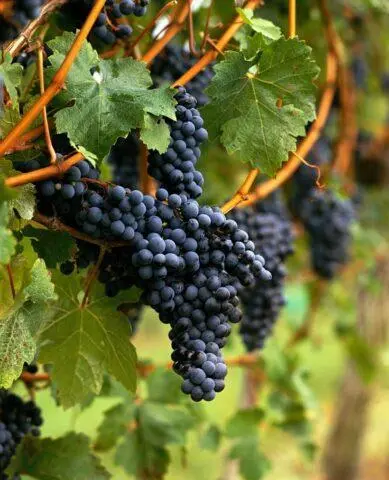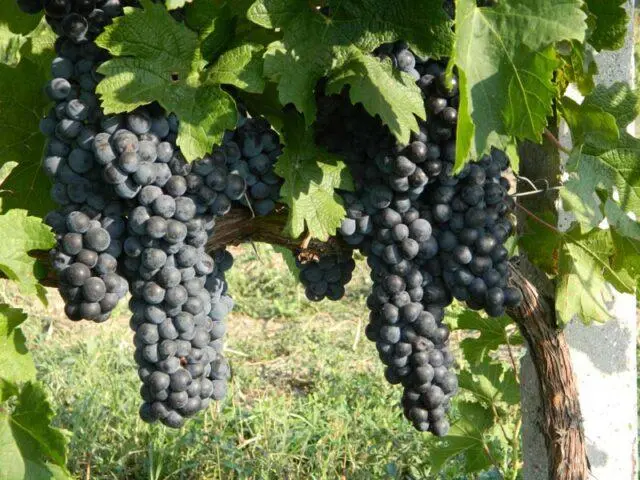Contents
Merlot grapes are one of the most popular wine (technical) varieties native to France. In terms of distribution in the world, only Cabernet Sauvignon is ahead of it. Merlot grapes and the wine made from them attract with a complex flavor that changes over time and depends on the timing of the harvest.
History of breeding
There is no exact data on the origin of the variety. Bordeaux is considered his birthplace. Translated from the Provencal (Occitan) language, the name of the variety means “young blackbird”. Some associate this with the beautiful blue-black color of the berries, others with the birds feasting on these fruits.
Scientists believe that the Merlot variety appeared under the Romans in the XNUMXst century. Written sources first mentioned it at the end of the XNUMXth century.
Scientists in the course of genetic studies have revealed that Merlot comes from the Western European technical grape Cabernet Franc and the ancient French variety Magdalen Noir de Charente.
Merlot was included in the State Register of the Federation only in 2002. The originator is the Kuban State Agrarian University named after I. T. Trubilin.
Description of Merlot grapes
The main purpose of growing Merlot grapes is the production of wine. It is not used fresh.
bunches
Merlot grapes have small clusters. Average length 15 cm. Main characteristics:
- average width 9-10 cm;
- diameter up to 14 cm;
- cylindrical shape, sometimes winged;
- average density;
- weight 130-135 g;
- leg length is medium.
The bunch contains 74% pure juice. About 22% falls on the dry part of the pulp, skin and seeds.
Berries
Merlot fruits are medium in size. Their main characteristics are:
- length 13,5 mm;
- width 12,5 mm;
- weight 1-1,4 g;
- round shape;
- color black;
- pronounced waxy coating of blue color;
- colorless juice;
- thin but strong skin;
- harmonious taste with a nightshade shade;
- juicy pulp;
- the number of bones up to three pieces;
- seeds are small, brownish-brown, length 4,5-5 mm, width 2,5-3 mm;
- average acidity 6,9 g/l;
- sugar content in 100 ml 20-22%;
- calories per 100 g 63 kcal.
Vine
Young shoots have gray tops with pink spots. The main characteristics of the vine are:
- dense felt pubescence;
- annual shoots are yellowish-brown after maturation, the nodes are darker;
- bisexual flowers;
- growth force is average.

Merlot grapes form strong or medium-sized bushes, the length of the shoots is 0,8-1 m, some reach 1,4-1,5 m
The size of the leaves of this variety is medium. They look like this:
- round shape;
- the reverse side is pubescent in the form of a rare cobweb;
- the color is green, there is a slight bronze tint;
- in autumn the color is yellow, red spots appear;
- five lobes with triangular teeth at the ends, their sides are slightly convex;
- funnel-shaped curvature;
- the depth of the upper cuts is average, more often they are closed, have an elliptical lumen and a prong at the bottom;
- notches of petioles are open, they are lyre-shaped or lancet.
Characteristics of the Merlot grape
The full growing season for the variety takes approximately 250 days. In the south of Crimea, leaf fall is observed at the end of the year
Maturation period
The State Register of the Federation classifies Merlot as a mid-late variety. Berries ripen in late September or early October. When the buds have blossomed, 152-164 days remain until technical ripeness. The lower limit of the term is recommended for table wines, the upper limit for the dessert category. Ripening of the vine to autumn frosts is 90-95%.
Merlot grape yield
The variety is high-yielding, fruiting steadily. According to official data, 1 centners are collected from 47 hectare, a maximum of 57 centners. Vine growers call other figures – 60-80 centners per 1 hectare on average, in the best years up to 150 centners. There are more than 52% of fruitful shoots on the bush.

The first harvest of Merlot grapes is usually harvested in the third year.
Taste qualities of Merlot grapes
Merlot grapes have a complex taste. It is presented in the following colors:
- fruits – plum, cherry notes, blueberries, mulberries;
- vegetables and spices – shades of black and green olive, mint, rosemary, fennel, truffle, leather and tobacco.
Taste shades of wine from grapes of this variety change with age. At first, berry aromas predominate, and after aging in a barrel, chocolate, coffee, caramel, vanilla notes appear.
Where grows
Merlot cultivates most of the world’s wine regions. According to the ecological and geographical features, the variety is considered Western European. It is most common on the shores of the Mediterranean, in Algeria. The variety is also grown in the USA, Chile. In Our Country, according to the State Register, the variety is recommended for the North Caucasus region.
Thanks to good winter hardiness, Merlot grapes can be grown even in the Moscow region. In such conditions, the culture must be covered for the winter. The best maturation indicators were noticed in the Krasnodar Territory.
Frost resistance
Merlot has medium frost resistance. In the spring of culture, they are not terrible, and in late autumn, with an immature vine, they can damage it and the kidneys. In winter, grapes can withstand temperatures as low as -20-22 °C.
Drought tolerance
The Merlot variety has medium drought tolerance. The frequency of watering is guided by weather conditions and soil composition.
Disease resistance
Merlot grapes are characterized by relative resistance to mildew and fruit rot. The variety is highly susceptible to oidium.
keeping quality
Merlot grapes are not intended for long-term storage. Even in a cool, well-ventilated room, the harvest will last only a few weeks.
Advantages and disadvantages
Winegrowers are happy to experiment with growing Merlot and making wine from it. The taste of the drink largely depends on the harvest time – if you do it earlier, the acidity will be higher, since the sugar content of the fruits is gaining slowly.

In warm summers, Merlot fruits accumulate more sugar, and in cool years, ripening is ahead of Cabernet Sauvignon.
Pros:
- relative immunity to fruit rot, mildew;
- good resistance to frost, drought;
- self-pollination;
- stable and high yield;
- seedlings are well rooted;
- rich bouquet of wine obtained from berries.
Cons:
- strong susceptibility to oidium;
- tendency to pea (small berries).
Features of growing Merlot grapes
The culture is planted by cuttings or seedlings. If the root system is open, then it is better to plan work for the end of spring or the beginning of summer, closed – for April-May. The soil should warm up to at least 10 °C.
The best option for the Merlot variety is clay soil and an admixture of sand. The site should be well lit and protected from the wind. Mandatory remoteness of groundwater at least 1,5-2 m.
Landing
Merlot grapes are planted according to the scheme 1,5×3 or 2×4 m. Neighborhood with nightshade is not recommended.
It is better to prepare a landing hole in the fall, in extreme cases, in the spring for 1-2 months. Separately, the fertile layer is removed, drainage of 15-20 cm is provided by pouring crushed stone or broken brick. The removed fertile layer is mixed with the following components:
- humus – 2,5 buckets;
- wood ash – 2 cups;
- urea – 0,1 kg;
- superphosphate – 0,2 kg.
Fill the hole with this mixture and water thoroughly. The further algorithm for planting Merlot seedlings is as follows:
- Install a plastic tube (section 5 cm) in the pit for irrigation.
- Pour fertile soil, leaving 0,5 m to the top.
- Liberally pour.
- After absorbing moisture, place the seedling in the hole, spread the roots evenly.
- Fill in the recess.
- Shade the seedling.
If you plant Merlot grapes with green cuttings, then you need to cut them at the beginning of flowering or two weeks before it. They make blanks of 45 cm, the lower leaves are removed, and the upper ones are shortened by 35-50%. The next algorithm is:
- Make oblique cuts below, put the cuttings in water (room temperature) for two days.
- Dip the tops for a couple of seconds in molten paraffin, treat the oblique sections with a growth stimulator.
- In the landing pit (prepared according to the standard algorithm), install the stake.
- Make a hole next to it, place the cutting there so that the surface of the soil is 5 cm above the lower eye.
- Fill in the recess, tamp.
- Water to settle the soil.
- After soaking up the water, add damp earth.
For reinsurance, two cuttings can be planted in each hole. If both take root, the weaker specimen is removed.

From the Merlot grown on calcareous soils, the wine turns out to be brighter in taste, the cultivation on sandy soil softens it.
Pruning Merlot grapes
The culture is pruned for sanitary purposes and for shaping. In the first case, all damaged and diseased branches are removed. This pruning is carried out in the spring.
To form a Merlot grape bush, old branches are removed to stimulate the growth of young shoots and increase yields. This pruning is carried out in the fall. The vines are shortened by 6-8 eyes.
The southern regions (Moldova, Ukraine) prefer Merlot’s multi-sleeved fan trim, medium or long. In Crimea, they make it short.
In addition to pruning, it is recommended to pinch the tops of the shoots before flowering or at its very beginning. This improves fruit set in the Merlot variety.
Conclusion
The Merlot grape is one of the most popular wine varieties. It has a medium-late ripening period, average resistance to frost and drought, good immunity to fruit rot and mildew. When growing a crop, it is important to provide comprehensive care, including competent and timely pruning, preventive treatments against oidium.









